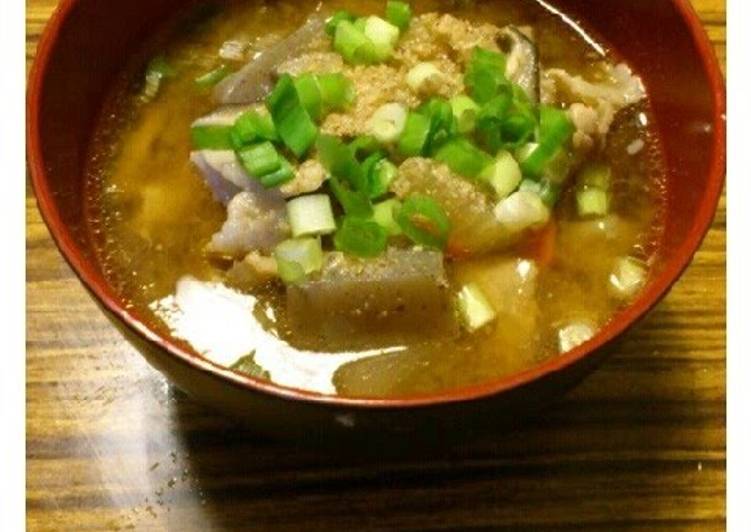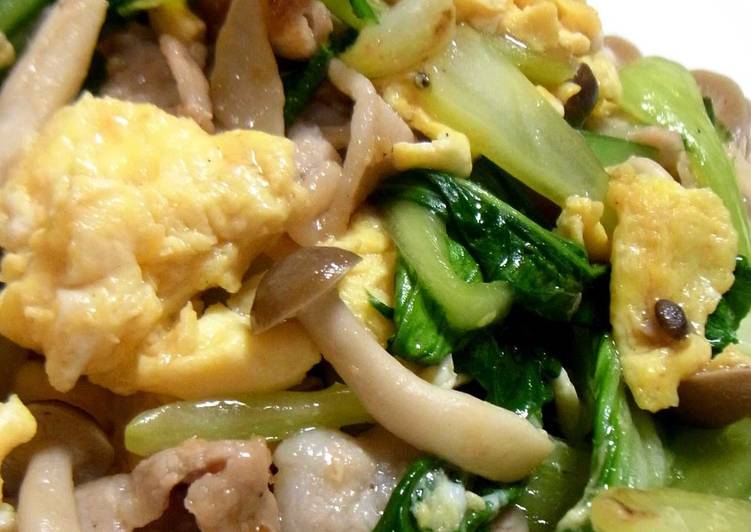
Hello everybody, hope you’re having an amazing day today. Today, we’re going to make a special dish, tonjiru (japanese pork soup). One of my favorites food recipes. This time, I will make it a little bit tasty. This will be really delicious.
Tonjiru (Japanese Pork Soup) is one of the most popular of recent trending meals in the world. It is simple, it’s fast, it tastes delicious. It is enjoyed by millions daily. They’re nice and they look wonderful. Tonjiru (Japanese Pork Soup) is something that I’ve loved my whole life.
Tonjiru is a savory miso soup with pork and root vegetables. Packed with an excellent source of vitamins, it's absolutely nourishing and soul-fulfilling! You might have seen Tonjiru being featured on the popular Japanese TV drama called "Shinya Shokudo (深夜食堂)" or "Midnight Diner: Tokyo.
To get started with this recipe, we have to first prepare a few ingredients. You can cook tonjiru (japanese pork soup) using 13 ingredients and 8 steps. Here is how you cook it.
The ingredients needed to make Tonjiru (Japanese Pork Soup):
- Prepare 150 grams Thinly sliced pork belly
- Make ready 1/2 Burdock root
- Take 1/2 a bunch Shimeji mushrooms
- Make ready 1/3 of a sheet Konnyaku
- Make ready 1/2 Carrot
- Make ready 5 cm Daikon radish
- Take 1/2 Aburaage
- Prepare 1 tbsp Sesame oil
- Get 2 tsp Dashi stock granules
- Prepare 800 ml Water
- Make ready 2 to 3 tablespoons Miso
- Make ready 1 Ground sesame seeds
- Make ready 1 Green onions or scallions
When I feel that a main dish might be slightly light, I sometimes make tonjiru instead of normal miso soup to. I've told you guys before about my tonjiru (豚汁) before, with big chunks of pork belly and vegetables, it's more like a hearty pork and miso stew than a soup. Tonjiru or Butajiru (豚汁,とん汁,とんじる) - both literally mean pig/pork soup — is a Japanese soup made with pork and vegetables, flavoured with miso. Compared to normal miso soup, tonjiru tend to be more substantial, with a larger quantity and variety of ingredients added to the soup.
Instructions to make Tonjiru (Japanese Pork Soup):
- Cut up the burdock root and put into a bowl of water with a little vinegar added. Cut the pork into 2 cm wide pieces. Cut the stem end off the shimeji mushrooms.
- Cut up the rest of the ingredients into bite-sized rectangular pieces. (De-grease the aburaage first by pouring boiling water over it).
- Heat up a pot and add the konnyaku. Stir fry until it makes squeaky sounds. (You can skip this step if you've parboiled the konnyaku.)
- Add the sesame oil to the pot and stir-fry the pork. When the color of the meat changes, add the vegetables and stir-fry.
- When everything has been coated with the oil, add the water and dashi stock granules. When it comes to a boil, remove the scum, reduce the heat to low and simmer until the vegetables are cooked through.
- Dissolve the miso and add to the soup. Turn the heat off just before the soup boils.
- Ladle into bowls, add some ground sesame seeds and chopped green onion, and it's done.
- I think it tastes better if you let it cool down once and re-heat it. Try the second bowl with some kimchi - it's delicious.
This tonjiru recipe combines miso soup with sliced pork and root vegetables for a hearty and filling soup meal that is quick and easy to prepare. Tonjiru (or Butajiru) is a kind of Miso Soup with pork and a lot of root vegetables such as Gobo (burdock root) and carrot. Even though it is a Miso soup, Tonjiru tastes very different from ordinary Miso Soup. Tonjiru has a distinct pork flavor and strong taste from Gobo. Easy recipe for Japanese tonjiru soup (pork and vegetables miso soup).
So that is going to wrap this up with this special food tonjiru (japanese pork soup) recipe. Thanks so much for your time. I am sure you can make this at home. There’s gonna be more interesting food at home recipes coming up. Don’t forget to bookmark this page in your browser, and share it to your family, colleague and friends. Thanks again for reading. Go on get cooking!


